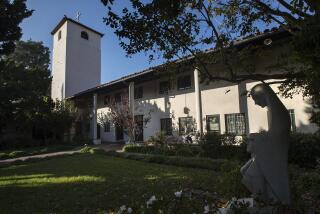Italy’s Hill Towns
- Share via
In his otherwise excellent article (“Hill Towns in Italy’s Heart,” July 30) Christopher Reynolds omitted an item of great interest.
On the plain below Assisi stands the basilica of Santa Maria degli Angeli. Inside the basilica is the church that St. Francis found in ruins . . . and rebuilt [as the center of the earliest Franciscan movement]. It was known then and now as the Porziuncula (little portion) after the small parcel of land on which it stood. In the 1780s, the Franciscan friars [who helped found the pueblo that would eventually become Los Angeles, the City of the Angels] named the initial settlement El Pueblo de Nuestra Sen~ora de los Angeles de Porciuncula. Thus every Angeleno traveling to Assisi will certainly wish to visit Santa Maria degli Angeli as well.
ANDREW LANDAY
Santa Monica
Christopher Reynolds is bothered that Saint Francis, who decried materialism, was honored by a “massive and ornately decorated church.” The absurdity of such reasoning is shown by the “benefits” the Russian people got after the Communists secularized churches and stole the art. Should we limit Jewish temples to tents because the prophets opposed materialism?
MICHAEL MURNANE
Tujunga
The articles on Umbria’s hill towns brought back some wonderful memories. In 1990-’91 my wife and I spent several months in Perugia. We rented a small apartment in a 15th-Century building that had been modernized--more or less. It had central heating and a tiny refrigerator. It was impossible to turn in the shower without hitting the sides. But we loved it, particularly the living room with its vaulted ceiling made of tiny Roman bricks.
The old city is walled--no supermarket, but many cheese stores, fruit and vegetable stores, bakeries, butchers (including one that sold only horse meat), and shops that sell the deliciously wonderful Perugia chocolates.
And finally, there’s the underground city. Some centuries ago the nobles in Perugia refused to pay the Pope’s salt tax. The Pope’s army conquered the city and enclosed the part where the nobles lived and roofed it over. The Pope then built his palace on top of the nobles’ homes. In the late 19th or early 20th Century, it was rediscovered and today one can wander through the underground city, still beneath the palace. And every fourth Sunday an antique market is held there. Ah. lovely, fascinating, wonderful Perugia.
RICHARD S. HULL
Laguna Niguel
I am filled with great joy and happiness reading the stories about Umbria. I was born and raised in Rome and left the city in 1946, never to return, so when I can read articles about la mia bella Italia, I imagine myself there and I dream someday to visit again. Mille grazie L.A. Times.
LYDIA PIZZOLI SMITH
Los Angeles
More to Read
Sign up for The Wild
We’ll help you find the best places to hike, bike and run, as well as the perfect silent spots for meditation and yoga.
You may occasionally receive promotional content from the Los Angeles Times.






